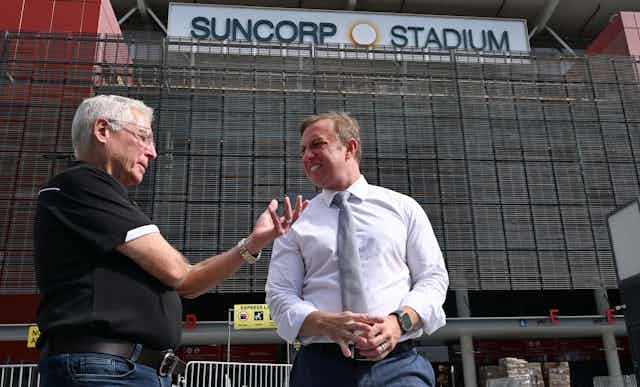When Queensland premier Steven Miles announced Brisbane’s Lang Park (sponsored name Suncorp Stadium) as the venue for the opening and closing ceremonies of the 2032 Olympic and Paralympic Games, he hoped, no doubt, it might finally lay to rest speculation about all the proposed Olympic venues and especially the Brisbane Cricket Ground (Gabba) rebuild.
But what does this mean more generally for the Games’ budget and for the legacy it will leave for Brisbane and south-east Queensland?
The Olympics’ ‘new norm’
The Olympic Games are famous for cost blowouts – every Olympics host since 1960 has spent significantly more than initial estimates, with an average spend of about 2.5 times the original budget.
These budget blowouts, and the cost of bidding simply to host the Games, have led to widespread criticism of the mega event.
In response to pressure to become more sustainable, the International Olympic Committee (IOC) introduced a series of reforms called the “new norm”. The IOC’s new norm was designed to reduce the costs of staging the Games by reducing the amount of new infrastructure required and encouraging the use of temporary and reusable venues.
These “new norm” principles are what made the Brisbane bid a more affordable and realistic proposal.
Since securing the Games in July 2021, there has been increasing public debate about whether the state government is keeping to these principles and can deliver a sustainable, legacy-driven event on budget.
Queensland’s stadium sagas
Brisbane’s IOC Future Host Commission Questionnaire Response, in effect the bid document, projected costs of A$4-5 billion, plus an additional $7.1 billion spend on infrastructure. This included using a refurbished Gabba as the main Olympic venue.
However, the former Queensland premier Annastacia Palaszczuk very quickly introduced a controversial plan to knock down and rebuild the Gabba from scratch.
Following strong criticism, Miles in December 2023 moved to commission an independent Sport Venue Review led by former Brisbane lord mayor Graham Quirk.
The report was released on March 18, and although the Queensland government accepted 27 of the 30 recommendations, one of its most significant was rejected. Controversially and seemingly in contradiction to the “new norm” principles, the review recommended building an entirely new stadium on a greenfield site at Victoria Park.
It also recommended the demolition of the Gabba once the new stadium was complete.
Miles was quick to rule out that recommendation, revealing he had been working for some weeks on an alternative proposal, instead announcing Suncorp Stadium would be the main stadium hosting the Games’ opening and closing ceremonies.
In another snub for the Quirk Review, it was also announced the Queensland Sport and Athletics Centre (QSAC) would be upgraded and serve as the venue for the athletics despite the review finding such as upgrade would not offer legacy benefits.
The choice of Suncorp Stadium appears to be a win for the “new norm”, as it saves around $3.4 billion that was earmarked for the Gabba rebuild, while using an existing venue that will remain as a legacy asset.
Revamping QSAC is also broadly in keeping with new norm principles if it provides a substantially upgraded asset for the community post-Games.
However, using Suncorp is not cost-neutral, with Miles suggesting that if upgrades cost upwards of $1 billion, this would be shared “roughly half-half” between Suncorp and the Gabba.
QSAC will also require a significant makeover to bring it up to standard and the venue is currently poorly served by public transport, and likely requiring further investment to enhance noted accessibility issues.
Additionally, costs will remain associated with the upkeep of the Gabba, described by the Quirk review as an “end-of-life” venue.
The Gabba is currently in desperate need of a refurbishment as it is not compliant with modern building codes, particularly in terms of accessibility for people with disabilities. The Queensland government has promised a “modest” refurbishment in consultation with stakeholders (AFL and Cricket Australia) in the range of $500 million.
The longer-term question still to be addressed is whether the redevelopment of these venues will provide Queensland with world class facilities that provide optimal long-term benefits for the community?
Lessons and next steps
What lessons can we draw from this recent experience?
Planning and development of major sporting events is always intensely political.
While it is crucial to avoid majorly expensive venues that will be rarely used after the Games, the IOC’s new norm should not necessarily mean entirely new venues are out of scope for host cities.
New venues may well align with new norm principles if they strongly support the long-term development plans of the host city and provide lasting community use after the Games have come and gone.
In the case of Brisbane 2032, getting the independent coordination authority set up is an urgent priority to provide a solid governance model for planning, design and construction of the proposed venues.
After something of a false start, we can ill afford further delays.

